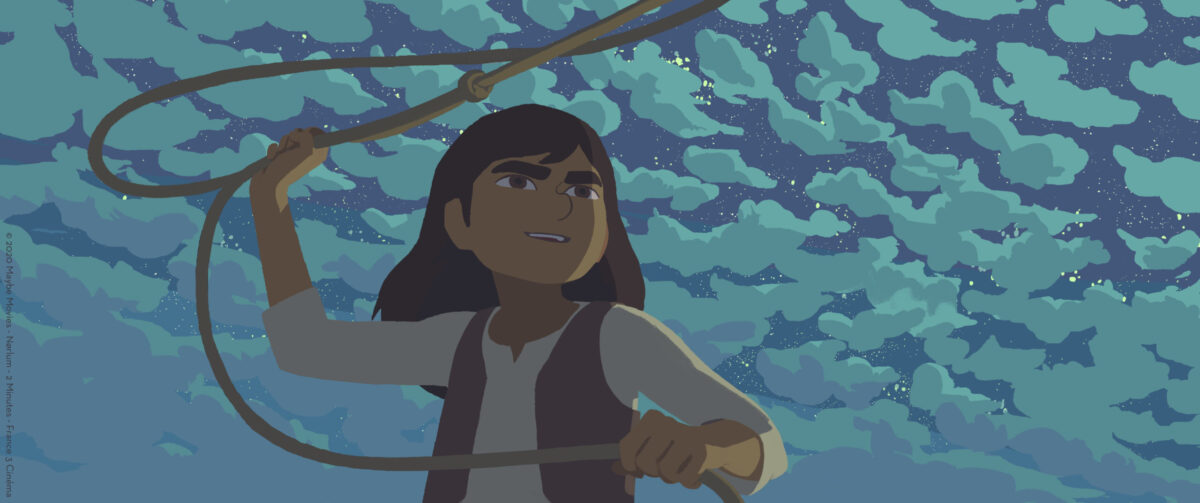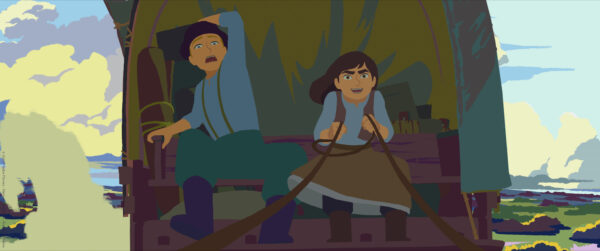Against the stereotypes. Rémi Chayé, the director of Calamity, a Childhood of Martha Jane Cannary, as interviewed by Kuba Armata

Kuba Armata: Calamity, a Childhood of Martha Jane Cannary turned out to be one of the most successful films of the 39. edition of the Ale Kino! International Young Audience Film Festival, winning two awards, including the Golden Goats for best feature film for children.
Rémi Chayé: Myself as well as the whole team working on the film – we were extremally happy when the verdict was announced. It is an important award. By the way, I also received some charming gifts from Poznań. You can tell it is a fantastic festival which I would definitely like to visit one day. Unfortunately this year – for obvious reasons – it was not possible. I was really pleased to see our animation resonate with Polish audience, especially as it tackles an important subject that has been much talked about in your country recently. Calamity is ultimately a story about a young girl who breaks down gender stereotypes.
In general, it is a story about equal rights, mutual respect and tolerance. Values with which we have recently fallen short, not only in Poland.
This is clearly visible in many places in the world, including France, where I come from. It seems to me that we were already a bit more advance in that respect. But apparently patriarchy is still very much alive and well. The number of women who suffer at the hands of their husbands or partners is still frighteningly high. Many of the problems we face today are linked to the position of women in the society. Our aim in making this film was to show young viewers what it means to be a boy and a girl, and the price you pay for the choices you make. But also we wanted to put it in a form that is attractive from the point of view of children and young people, where there is room for fun and adventure. Calamity, a Childhood of Martha Jane Cannary is about what happens when, in a conservative, traditional society, someone wants to cross the line.
So it’s simply a story about breaking gender stereotypes?
Definitely. The main character of our film is an alternative to the typical image of a young girl. My previous film, Long Way North (2015) presented a similar concept. It is a story, framed in the formula of adventure animation, about a girl who sets off to the North Pole, following the journey of her grandfather. Calamity Jane, on the other hand, breaks stereotypes on various levels. She dresses like a boy and performs tasks meant for men. We wanted to show the young viewers that there is more than just one way – no one will tell the character that she has to behave in a certain way because of her gender. After all, gender doesn’t have to involve a particular attitude. It is rather an established social construct.
Both of those films are set in historical reality. Is that a good way to talk about universal values?
Absolutely, especially since I’m very fond of the 19th century. It was a unique and important time for us, full of new inventions, discoveries, undeveloped land. In today’s world, this is practically absent. Every space, even the smallest one, is basically occupied. Back then, there was no technology that would allow us to stay in constant touch with family and friends as we do today. This meant that the very idea of travelling was a little different and involved more unexpected adventures. I am also very fond of the symbols associated with the pre-industrial world – carriages, horses, everything connected with life in those days. It’s not even about nostalgia, because it’s hard to idealise times when life was really tough and people could die at any moment, but I think it is a good background for a story.
I guess we can learn a lot from history too.
It is a good tool for building links between the past and the present. Knowing history is a superb way to gain understanding of various mechanisms and avoid making the same mistakes. Of course, not everything can be explained by what had been before. However, it is good to know history in order to better understand the world, politics, social movements, relations between men and women. It was important for me to read about the history of the Wild West and my protagonist before making this film, as it allowed me to acquaint myself better with the subject.

When did you come up with the idea that you wanted to tell the story of one of the legends of the American Wild West?
Actually right after I finished my previous film which we already mentioned, Long Way North. One of the co-producers of that animation said that he would like to continue the collaboration, so I started thinking about the next subject. I had a few ideas, but then I saw a documentary about the story of Calamity Jane. It said that as a young girl she had walked the famous Oregon Trail. It is a route along which settlers travelled in the past, starting in St Louis and spanning around 3000 km. She was only ten years old at the time. Her family accompanied her, and I began to wonder what would have happened if her father had had an accident. She would have to take over some of his duties – driving, getting the wagons across the river, taking care of the horses. I thought that might be interesting and to some extent explain who she would become later in life. And she was, after all, one of the legends of the Wild West. The idea started to take shape in my head, I had a sense that this was the type of story I wanted to tell. I was also very drawn to the vision of the majestic American landscape. It was a good starting point. This idea appealed to two screenwriters I had worked with previously. Together we wrote a three-page treatment and presented it to the producer.
You were also kind of lucky since – as you mentioned – no one had dealt with the topic of Calamity Jane’s past before.
Certainly, although the story we present is pure fiction – our variation on Calamity Jane’s youth. There is no reliable historical testimony relating to this period of her life. The only knowledge we have regards the migration itself and the extremely difficult conditions, but that’s it. The rest is made up. We studied the adult life of Calamity Jane, we read biographies, many materials about the Wild West, the situation of women at the time. It was important, but also not easy, because there are many misrepresentations about our heroine. Also because both herself and her sister often lied. There were quite a few different stories, legends, songs about her. She was portrayed in many different ways. You had to be very careful and find your way through all this content.
I was really impressed by the animation itself. The colour palette evoked associations with impressionism.
The first ground rule we established was not to use outlines. This meant that there was no clear line separating the figure of a character from the landscapes, which allowed us to open up to the colour palette strongly. We were certainly inspired by impressionism and nabism. These artists used deeply-saturated colours, and we wanted to create a strong visual experience for the viewer. Digital technology allowed us to create such mixtures of colours and colour variations which strongly resemble what you see in museums. Also in the context of American landscape painting – another strong inspiration. Initially, we wanted to create a separate colour palette for each scene, but as there were 1200 of them, we decided that it would be enough if it was different for each sequence.
Could both of your films be described as feminist?
I think you could say that. I strongly support feminist movements. But you have to remember that these are films for young audiences and they have to contain a certain amount of fun, action and adventure. They certainly want to show the girl characters in a slightly different way than in the fairy tales we – as adults – know from our youth. They are no longer princesses who do nothing but wait for great love.
Interviewed by Kuba Armata


